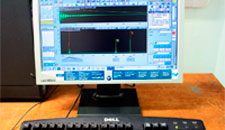Nuclear Magnetic Resonance


Introduction
NMR spectroscopy works by detecting the nucleus of hydrogen (or carbon or certain other types of atomic nuclei) using radiowaves. The samples have to be placed in a strong magnetic field during the experiment. It turns out that the exact chemical environment that a hydrogen atom is located in determines the energy of radiowaves that can be absorbed. Hydrogen atoms in water absorb different energies than those in other types of molecules such as methane or alcohol. Even hydrogen atom nuclei located in different parts of the same molecule absorb slightly different radiowave energies. This means that the NMR spectroscopist can easily identify the number of different types of hydrogen present in a molecule simply by counting the number of signals in the NMR spectrum, and with experience can identify the exact type of chemical groups present (eg CH2, CH3, OH etc).
NMR spectroscopy is the most powerful technique available for identifying the structures of molecules and modern chemistry would be impossible without it.
NMR spectroscopy is used for the characterisation and identification of solids and liquids.
It relies on a fundamental property of atomic nuclei, the spin. Within the instrument, the sample is subjected to two magnetic fields. The first field is produced by a magnet and has a constant intensity. The second field is produced by an electromagnetic radiation source. This latter field is approximately 10,000 times weaker and is variable. Atoms within the sample can absorb this electromagnetic radiation at a given frequency depending on their chemical environment.
Complex organic molecules, for example, will contain many atoms in different chemical environments, leading to absorption at numerous frequencies. By noting the intensity and frequency of these absorptions, the NMR spectrum is produced.
Interpretation of the spectrum (i.e. intensity, position & appearance of absorption signals) can assist with detailed structural analysis of the sample. The technique is most commonly used for hydrogen nuclei, hence its importance in organic chemistry, though other nuclei such as carbon-13, phosphorus-31 and fluorine-19 are routinely studied.
NMR spectroscopy is the most powerful technique available for identifying the structures of molecules and modern chemistry would be impossible without it.
Applications
Characterisation and identification of solids and liquids by hydrogen-1, carbon-13, phosphorus-31 and fluorine-19 spectra. The technique can be utilised for elucidating the chemical structure of samples and therefore is of great interest to both organic and biological chemists.
Instrumentation
- Bruker 300 MHz Fourier Transform Nuclear Magnetic Resonance Spectrometer (FT-NMR).
- 1H, 13C, 31P and 19F probes.
- 2-dimensional correlation capability (e.g. H-H, C-X)
If the service you require is not listed on this web site, please contact us, we will be happy to help you.
NMR Pricing
| Nucleus Type | £ |
| 1H | 60 |
| 13C | 100 |
| 19F | Contact Us |
| 31P | 100 |
| 2-Dimensional | Contact Us |
If your NMR Requirement is not Listed, please contact us.